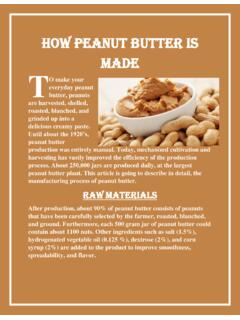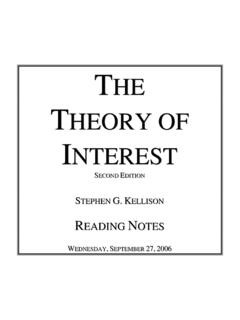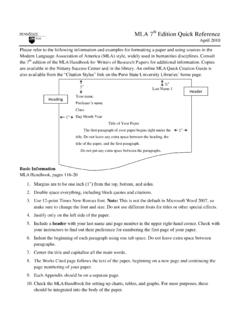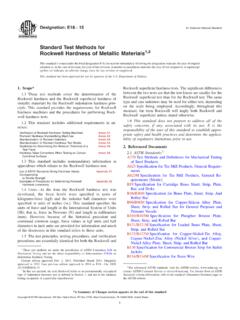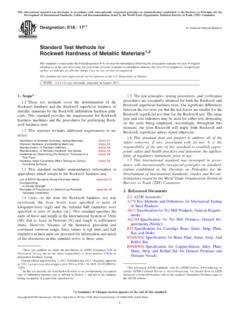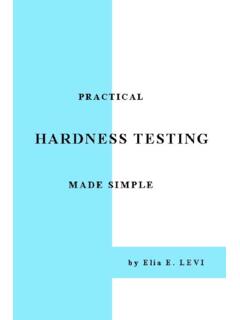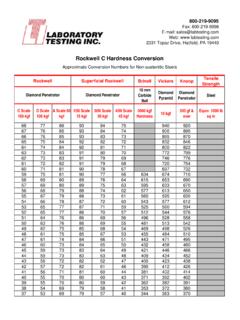Transcription of Tensile Testing and Hardness Testing of Various Metals
1 Tensile Testing and Hardness Testing of Various Metals Technical Report Submitted to: Dept. of Industrial & Manufacturing Engineering Prof. Edward C. De Meter 310 Leonhard Building The Pennsylvania State UNiversity University Park, PA 16802 Submitted by: Team: 4 Pavel Shusharin, Erik Venuti Matthew Prevost David Hontz Date: 2/10/16 Table of Contents Methodology Analysis Analysis of data obtained with an extensometer Analysis of true stress strain for ductile materials Investigation Methodology The Metals that were tested in the lab: Cold Rolled Annealed Steel 6061 Aluminum 1018 Hot Rolled Brass Cast Iron Our group tested.
2 Cold Rolled Annealed Steel The measurements that were taken: 1) Tensile Test a)Time b)Position c)Force d)Change in length 2)Rockwell Hardness 3) brinell Hardness 4)Pre Tensile Test measurements a)Gage Width b)Gage Thickness c)Gage Length 5)Post Tensile Data a)Gage Width b)Gage Thickness c)Permanent Length Between Jaw Alignment Marks The Mechanical properties that were derived: 1)Young s Modulus 2)Engineering and True Strain at Yield point 3)Ultimate Tensile Stress 4)Engineering and True Strain at UTS 5)Ductility 6)Engineering and True Shear Strain 7)True Strain at Fracture 8)Measured and Predicted Max True Stress 9)Strain Hardening exponent 10) Strength Coefficient 11) Predicted toughness Analysis of data obtained with an extensometer.
3 For each metal: Engineering stress strain plot with a figure caption Additional graph that shows a offset and includes a trend for the linear portion of the graph Table with e 0 , e u , E, y (shear strain), UTS and ductility. Brass Figure Engineering stress strain plot for Brass The shape of this plot indicates this Brass is a ductile metal It does not appear the extensometer slipped during this Tensile test Figure Engineering stress strain plot of the elastic region with offset Table Table of mechanical properties of Brass e 0 (in/in) e u (in/in) E (ksi) y (ksi) UTS (ksi) Ductility (%) 16042 35 6061 Aluminum Figure : Engineering Stress vs.
4 Strain plot for Aluminum Specimen Ductility: 6061 Aluminum exhibits a large region of plastic deformation before fracture which is indicative of ductility. Figure : Zoomed Engineering Stress vs. Strain displaying offset for Aluminum Specimen. Extensometer: The data contains a slight discontinuity at the beginning of the test which indicates that the extensometer slipped. Table Mechanical properties of 6061 Aluminum o ( ) u ( ) E (ksi) (ksi) UTS (ksi) Ductility 16% 1018 Hot Rolled Steel Figure Engineering Stress vs Strain plot for 1018 Hot Rolled Steel Figure Zoomed Engineering Stress vs Strain plot of 1018 Hot Rolled Steel displaying offset Comments: Based on this data, the 1018 Hot Rolled Steel specimen exhibits significant ductility due to its large plastic deformation.
5 The data shows a slight discontinuity at the beginning of the test, indicating that the extensometer slips for a brief moment. Table Mechanical properties of 1018 Hot Rolled Steel e 0 (in/in) e u (in/in) E (ksi) y (ksi) UTS (ksi) Ductility .0035 .01912 *10^6 Cast Iron Figure : Engineering Stress vs. Strain for Cast Iron Specimen Ductility: The data shows almost no signs of plastic deformation which indicates that Cast Iron is not ductile. Table Mechanical Properties of Cast Iron o ( ) u ( ) E (ksi) (ksi) UTS (ksi) Ductility N/A N/A 15118 N/A 1018 Annealed Steel Figure : Engineering Stress vs.
6 Strain for the 1018 Cold Rolled Steel Figure : Zoomed Engineering Stress vs. Strain displaying the offset and elastic region. Comment: Based on this data, the 1018 Cold Rolled Steel specimen exhibits significant ductility due to its large plastic deformation. The data is very smooth and does not exhibit any discontinuities indicating that the extensometer did not slip during Testing . Table Mechanical properties of 1018 Annealed Steel o ( ) u ( ) E (ksi) (ksi) UTS (ksi) Ductility % 24128 42 Analysis of true stress strain for ductile materials For each ductile metal: True stress strain plot A table with y t , ms t max (measured maximum true strain), k, n, ps t max (predicted maximum true strain) and predicted toughness.
7 Brass Figure A true stress strain plot, including a flow stress equation and trendline For this metal, the predicted value for maximum true strength was reasonably close to the actual value. This measurement has an error, which is slightly than the other Metals tested. Table Mechanical properties evaluated from true stress strain plot y t (ksi) ms t max (ksi) k n ps t max predicted toughness (in/in) e 0 in/in e u in/in E 16032 ksi ksi UTS ksi Ductility 35 % e f in/in t max ksi ksi Toughness lb/(in/in) 3 Aluminum Figure True Stress vs.
8 Strain plot for Aluminum Specimen Table Mechanical properties evaluated from true stress vs. strain plot t (ksi) (ksi) measured t max (ksi) predicted t max (ksi) predicted toughness (lb* ^3) Comments: 1018 Hot Rolled Steel Figure True Stress vs Strain plot for 1018 Hot Rolled Steel. The first (blue) data set represents strain data from 0 to 0 . The second (red) data set represents strain data from 0 to u . The third data set (green) represents the predicted failure point corresponding to f and t max . Table Mechanical properties evaluated from true stress vs.
9 Strain plot yt (ksi) (ksi) f (in/in) t max Predicted (ksi) t max Flow Stress (ksi) Toughness (lbf*in/in^3) .064 .0863 The value for predicted t max was very close to the actual value obtained with the data, varying by only ksi and yielding a mere error. 1018 Cold Rolled Steel Figure True Stress vs. Strain for the 1018 Cold Rolled Specimen The value for predicted t max was much less than the actual value obtained with the data. This is because the measured value takes into account the instantaneous cross sectional area, while the predicted value uses the original cross sectional area.
10 The values vary much more for the annealed steel than the other materials because of the annealed steel s high ductility. Table Mechanical properties evaluated from true stress vs. strain plot yt (ksi) (ksi) f (in/in) t max Predicted (ksi) t max Flow Stress (ksi) .3506 Analysis of data obtained with an extensometer. Cold Rolled Annealed steel Figure Engineering Stress Strain plot for Cold Rolled Annealed Steel Figure Engineering Stress Strain plot of the elastic region with offset e 0 (in/in) e u (in/in) E (ksi) y (ksi) UTS (ksi) Ductility % Based on the data for the five specimens, the material that would be the easiest to form into a shape would be 1018 Annealed Steel.
